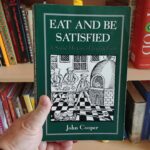The time has come to write about the last of my all-time top three Jewish Food books. I previously spoke about Gil Marks’ Encyclopedia of Jewish Food and John Cooper’s Eat and Be Satisfied. This third one is probably the best known: The Book of Jewish Food by Claudia Roden.
As I mentioned previously, each of these three books is rather different from the other two. Marks’ book is (as the name suggests) an encyclopedia, and a very comprehensive one at that, and Cooper’s is a somewhat academic history that successfully blends a succinct approach with a surprising degree of depth. Roden’s book, meanwhile, is the most cookbook-like of the three, including 800 or so recipes. But beyond that, The Book of Jewish Food also offers tens of longer form essays on history of different communities, and introductions to categories of foods or dishes. Beyond those, the headnotes for many of the recipes stretch longer than the standard, operating as mini-essays of a few paragraphs each.
A Pioneering Work
Roden’s book broke new ground in the field when it was first published in 1996. It was one of the first comprehensive texts to explore the diversity of Jewish Food, beyond that of one or two sub-communities. While it doesn’t touch on the foods of every Jewish community (which would be extremely difficult, considering how globalized a nation we are), it approaches the topic way more broadly than most prior works (with which I am familiar) on the subject. Hence the subtitle of her book, “An Odyssey from Samarkand and Vilna to the Present Day.”
The wrangling and organizing of such voluminous quantities of materials — recipes, historical elements, illustartive photographs, entertaining stories and tidbits, etc. — was a task in itself. But the result is a beloved book that one can equally enjoy as a cover-to-cover read through, a random and haphazard perusal, and a targeted search for something specific. This explains why The Book of Jewish Food is still in print nearly 30 years after its initial publication.
Some Surprising Pros

Roden explains that the mistaken belief stems from the complexity of Jewish cuisine, made up of people from all over the world who eat drastically different things. “But,” she continues, “because a culture is complex this does not mean it does not exist.” And the same applies to food. At the time of writing, she explains that she has come to realize how the many foods that Jews eat in each part of the world, though different from each other, are also “sometimes quite different from the local cuisine.”
I agree wholeheartedly, and it is a topic that is near and dear to my heart. (I will be discussing it in greater depth in a few weeks at my FED talk in NYC on Nov 1st, so come check it out if the topic interests you!) More importantly, however, I like that it shows how Roden was continuing to think about the topic, revising her attitudes and opinions with further information.
Another, perhaps unexpected positive is that this book is not like most food books today. This book could not be published now, or to put it more accurately, if it were, it would be a completely different book. Roden’s work is heavy on content, with almost no “big and beautiful” pictures. The pictures that are included are small and in black and white. The recipes not laid out in a classic cookbook one-per-page format. But those recipes are no less useful or inspiring in the form in which they are presented. And had the book been formatted in they style that is common today, it would be too voluminous to be published. And at whatever length it was printed, the cost would still be 2-3 times as expensive. (As an apt comparison, Leah Koenig‘s excellent and much more recent The Jewish Cookbook contains about half as many recipes, significantly fewer and shorter essays, and that while covering slightly greater territory in breadth.)
Nothing is Perfect
As always, I must note a few small shortcomings. Really, these are largely quibbles, but all works, great or otherwise, can be better.
One of my greatest pet peaves with many books of Jewish food scholarship, this work included, is that they are unsourced. So whenever Roden writes something that seems perhaps mistaken or inaccurate (and every author will make mistakes of this nature at some point), it is impossible to research how she reached her conclusions. Thus, if I read something that rings false, I can only question it generically, and it becomes significantly harder to explore whether or not she was mistaken. Again, Roden is not alone in this, but it is a problem that does irk me.
Similarly, since much of Roden’s research was done by gathering information from individual home cooks, she has a tendency (as did Cooper as well, by the way) to extrapolate broadly from a single example to an entire community. There is nothing wrong with saying that you have found an interesting example of a certain dish cooked by a member of a certain community. But this is not synonymous with saying that the Jews of that community make this dish in this way. Every home cook does things differently, so without finding multiple examples, one has done little more than found one iteration.
Finally, Roden also does something else that bothers me, by dividing the Jewish world into a largely binary thing: Ashkenazi and Sephardi. Admittedly, she recognizes this as the oversimplification it is, but I’d still prefer to avoid it entirely. And she still lumps all of Ashkenazi food together, without fully recognizing that it is as separate from country to country as is Sephardic, or Mizrachi, or other communities’ food.
Still, you can’t really go wrong in purchasing this book. With Channukah only about 2 months away, think of getting it is a gift for a foodie friend, or for yourself! This timeless classic will feel right at home on anyone’s Jewish Food Bookshelf.





